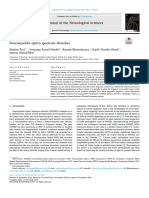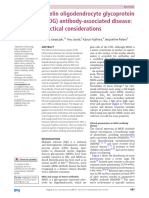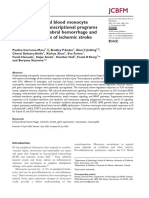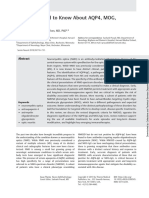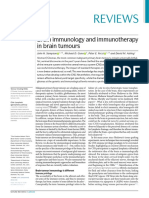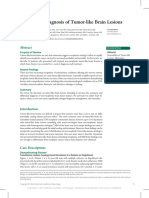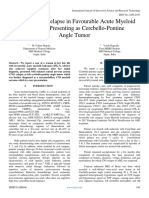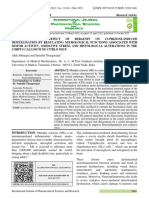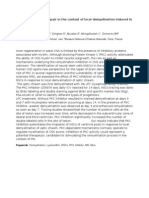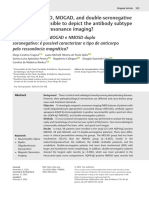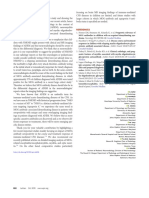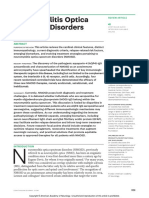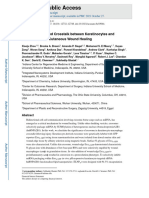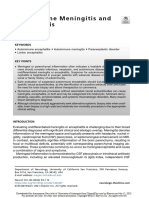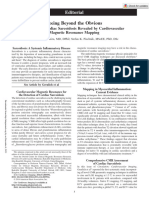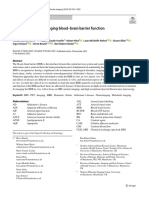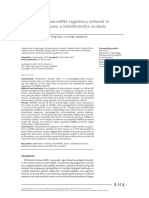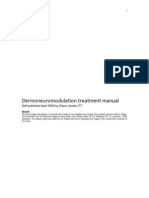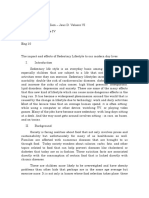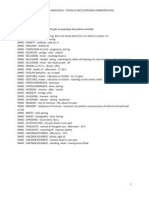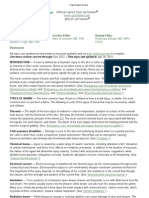Fimmu 12 644213
Fimmu 12 644213
Uploaded by
Gloria SagalaCopyright:
Available Formats
Fimmu 12 644213
Fimmu 12 644213
Uploaded by
Gloria SagalaOriginal Title
Copyright
Available Formats
Share this document
Did you find this document useful?
Is this content inappropriate?
Copyright:
Available Formats
Fimmu 12 644213
Fimmu 12 644213
Uploaded by
Gloria SagalaCopyright:
Available Formats
ORIGINAL RESEARCH
published: 16 March 2021
doi: 10.3389/fimmu.2021.644213
Monomeric C-Reactive Protein
Localized in the Cerebral Tissue of
Damaged Vascular Brain Regions Is
Associated With Neuro-Inflammation
and Neurodegeneration-An
Immunohistochemical Study
Raid S. Al-Baradie 1*, Shuang Pu 2,3 , Donghui Liu 3 , Yasmin Zeinolabediny 3 , Glenn Ferris 3 ,
Edited by:
Pietro Ghezzi,
Coral Sanfeli 4 , Ruben Corpas 4 , Elisa Garcia-Lara 5 , Suliman A. Alsagaby 1 ,
Brighton and Sussex Medical School, Bader M. Alshehri 1 , Ahmed M. Abdel-hadi 1 , Fuzail Ahmad 5 , Psalm Moatari 6 ,
United Kingdom Nima Heidari 7 and Mark Slevin 2,8*
Reviewed by: 1
Department of Medical Laboratory Sciences, College of Applied Medical Sciences, Majmaah University, Al Majma’ah, Saudi
Alok Agrawal, Arabia, 2 National Natural Science foundation of China, Beijing, China, 3 School of Healthcare Science, John Dalton Building,
East Tennessee State University, Manchester Metropolitan University, Manchester, United Kingdom, 4 Instituto De Investigaciones Biomedicas De Barcelona,
United States CSIC, Barcelona, Spain, 5 Department of Physical Therapy and Health Rehabilitation, College of Applied Medical Sciences,
Sabina Janciauskiene, Majmaah University, Al Majma’ah, Saudi Arabia, 6 Salford Royal NHS Foundation Trust, Manchester, United Kingdom, 7 The
Hannover Medical School, Germany Regenerative Clinic, London, United Kingdom, 8 University of Medicine, Pharmacy, Science and Technology, Târgu Mures,
*Correspondence: Romania
Raid S. Al-Baradie
r.albaradie@mu.edu.sa
Mark Slevin
Monomeric C-reactive protein (mCRP) is now accepted as having a key role in modulating
m.a.slevin@mmu.ac.uk inflammation and in particular, has been strongly associated with atherosclerotic arterial
plaque progression and instability and neuroinflammation after stroke where a build-up
Specialty section:
of the mCRP protein within the brain parenchyma appears to be connected to vascular
This article was submitted to
Inflammation, damage, neurodegenerative pathophysiology and possibly Alzheimer’s Disease (AD) and
a section of the journal dementia. Here, using immunohistochemical analysis, we wanted to confirm mCRP
Frontiers in Immunology
localization and overall distribution within a cohort of AD patients showing evidence
Received: 20 December 2020
Accepted: 22 February 2021
of previous infarction and then focus on its co-localization with inflammatory active
Published: 16 March 2021 regions in order to provide further evidence of its functional and direct impact. We
Citation: showed that mCRP was particularly seen in large amounts within brain vessels of all
Al-Baradie RS, Pu S, Liu D,
sizes and that the immediate micro-environment surrounding these had become laden
Zeinolabediny Y, Ferris G, Sanfeli C,
Corpas R, Garcia-Lara E, with mCRP positive cells and extra cellular matrix. This suggested possible leakage
Alsagaby SA, Alshehri BM, and transport into the local tissue. The mCRP-positive regions were almost always
Abdel-hadi AM, Ahmad F, Moatari P,
Heidari N and Slevin M (2021)
associated with neurodegenerative, damaged tissue as hallmarked by co-positivity with
Monomeric C-Reactive Protein pTau and β-amyloid staining. Where this occurred, cells with the morphology of neurons,
Localized in the Cerebral Tissue of
macrophages and glia, as well as smaller microvessels became mCRP-positive in regions
Damaged Vascular Brain Regions Is
Associated With Neuro-Inflammation staining for the inflammatory markers CD68 (macrophage), interleukin-1 beta (IL-1β) and
and Neurodegeneration-An nuclear factor kappa B (NFκB), showing evidence of a perpetuation of inflammation.
Immunohistochemical Study.
Front. Immunol. 12:644213.
Positive staining for mCRP was seen even in distant hypothalamic regions. In conclusion,
doi: 10.3389/fimmu.2021.644213 brain injury or inflammatory neurodegenerative processes are strongly associated with
Frontiers in Immunology | www.frontiersin.org 1 March 2021 | Volume 12 | Article 644213
Al-Baradie et al. Monomeric C-Reactive Protein and Vascular Neurodegeneration
mCRP localization within the tissue and given our knowledge of its biological properties,
it is likely that this protein plays a direct role in promoting tissue damage and supporting
progression of AD after injury.
Keywords: vascular, neurodegeneration, C-reactive protein, stroke, inflammation
INTRODUCTION TABLE 1 | Table of patients/samples.
Alzheimer’s disease (AD) is the most common form of dementia, Number Age Sex Diagnosis-1 Diagnosis-2
a brain degenerative disease affecting 1:14 of the population
893F 71 M AD CAA
over 65 years of age (1). The disease is irreversible and current
883BG 91 F CVD CONTROL-
therapeutics can only slow down progression of the disease (2).
916OCC 72 F VaD MELANOMA
Our previous work showed that monomeric C-reactive
850F 79 M AD CVD
protein (mCRP) is found in large amounts in the parenchyma
798PAR 95 F AD CVD
following ischemic or hemorrhagic stroke and appears to
954OCC 84 F AD CVD
originate mainly from blood vessel leakage into the local
839F 71 M AD CAA
surrounding tissue (3, 4). Dementia of vascular origin is
963PAR 71 M AD CAA
associated with damage to the deep penetrating arteries within
855BG 93 F TBI CONTROL
the parenchyma and this can result from head trauma, ischemic,
815F 70 M AD –
or hemorrhagic stroke or linked to genetic abnormalities
697PAR 75 M AD CAA
particularly in younger patients (5, 6).
839HYPO 81 M AD CAA
Chronic neuroinflammation is a key determinant of
ongoing and future likelihood of development of cognitive 691F 77 F VaD –
impairment and subsequent risk of AD (7), whilst, acute vascular
F, frontal; BG, basal ganglia; OCC, occipital; PAR, parietal; AD, Alzheimer’s disease; CVD,
events associated with stroke, other injury or repeated minor cardiovascular disease; VaD, vascular dementia; CAA, cerebral amyloid angiopathy; TBI,
disturbances found in lacunar stroke, also predispose individuals traumatic brain injury; HYPO, hypothalamus. All samples were chosen from the brain bank
significantly to neurodegenerative complications (8, 9). on the basis that AD/VAD was the primary diagnosis at post-mortem. The selection here
apart from the controls represent those that subsequent histology revealed an additional
C-reactive protein in general, has been used particularly in the presence of infarct.
fields of cardiovascular disease and autoimmune conditions as
well as sepsis to indicate levels of inflammation, however over the
last decade, its monomeric form (mCRP) has been highlighted as histological pre-examination) where all hemispheres/regions of
the major biologically active form, and both circulating levels of tissue were available from the Brain Bank in Bristol (UK).
CRP as well as tissue-associated mCRP within the brain have been Tissue sections were cut from paraffin blocks of separated
shown to be associated with development of dementia (10). regions from the cerebral cortex, as follows: (1) frontal lobe, (2)
mCRP strongly activates angiogenesis both in vitro parietal lobe, and (3) occipital lobe (Table 1). All cases had a
and in vivo through a mechanism involving MAP kinase history of progressive dementia some with evidence of stroke
signaling and Notch-3, but this vasculogenic process and each was selected on the basis of a diagnosis according
appears to be flawed often producing in patent or leaky to CERAD of “definite AD and a Braak tangle stage of V–VI;
blood vessels (11). It is interesting therefore to examine according to NIA-Alzheimer’s Association guidelines, where the
the brain vasculature in relation to local inflammatory AD neuropathological change was the gold standard registering
status as this may provide an insight into the developing the patient as dementured.
neurodegenerative process. Ethical approval was gained through application to https://
Prior studies have demonstrated mCRP localization in the mrc.ukri.org/research/facilities-and-resources-for-researchers/
plaques of individuals with AD (12). Here, we investigated brain-banks/, and following their guidelines at https://mrc.
the link between mCRP and its co-localization within the ukri.org/publications/browse/human-tissue-and-biological-
brain and indicators of previous stroke or vascular disruption samples-for-use-in-research/; local approval was gained for
and dementia. In addition, we used co-labeling to confirm the use of the tissue within the Manchester Metropolitan
a direct association of mCRP-positive regions with neuro- University LREC committee)-more details are shown in
inflammatory processes. Slevin et al. (13), Mirra et al. (14), Braak et al. (15), and
Montine et al. (16). Some of the patients had evidence
METHODS of infarction from previous stroke, peri-infarcted tissue
showed structural integrity that was characterized by oedema,
Tissue Sample Collection altered morphology of the neurons (some showing changes
Alzheimer’s tissue obtained at post-mortem was obtained from of apoptosis), inflammatory macrophage infiltration and
a total of 13 patients (identified from a larger cohort by angiogenesis. Tissue with regular looking morphology served as
their co-existence of previous infarction as determined by a control.
Frontiers in Immunology | www.frontiersin.org 2 March 2021 | Volume 12 | Article 644213
Al-Baradie et al. Monomeric C-Reactive Protein and Vascular Neurodegeneration
Stereotactic Hippocampal Injection of polyclonal CD68, IL-1β or phospho-NF-κB (InVitrogen, UK;
Mcrp in Mice and Histological Analysis 1:50 in 1% Goat serum/0.1% Tween 20/1x PBS) for 18 h at
Methodological details for this previously conducted work, and 4◦ C, followed after washings by the second antibody, detected
treatment are provided in the article by Slevin et al. (13) where using a mix of goat anti rabbit CFL 488 and goat anti-mouse
in Figure 4E of this already published article, an image is CFL 568 (1:100, Santa Cruz, Heidelberg, Germany) in 1% Goat
displayed showing mCRP-positive neurons in the hypothalamus serum/0.1% Tween 20/1x PBS for 4 h at room temperature.
of mice (shown here as Figure 2E). Further images from these Several color combinations were used in co-labeled sections
experiments are provided in the results section to qualify depending on the need and these are described in the figure
this finding. legends. Regions of tissue with normal looking morphology that
in addition did not show mCRP staining from the same sections
are included as controls.
Immunohistochemistry and Double
Sections were mounted in DPX (Life Technologies, Karlsruhe,
Labeling Procedures Germany) and slides were visualized on confocal microscope.
mCRP-specific monoclonal antibody 8C10 was prepared and Control cases were stained with a standard diaminobenzidine
supplied by Dr. Lawrence Potempa and fully characterized as staining. Negative controls were included where the primary
shown in the article by Schwedler et al. (17). antibody was replaced with PBS- the primary antibody showed
Single and double immunofluorescence was performed after no abnormal cross reactivity.
antigen retrieval (slides incubated for 40 min in 0.01 M of sodium
citrate buffer at a pH of 6.0 and a temperature of 95◦ C), cooled
at room temperature and stored for 30 min in a 2% hydrogen RESULTS
peroxide solution.
After blocking for 1 h in 10% goat serum, the slides were Monomeric C-Reactive Protein Staining
incubated alone or sequentially over night with anti- mouse Profiles
monoclonal mCRP-8C10 antibodies (obtained as a gift from Of the 13 patient samples examined, 10 showed significant
Professor Lawrence Potempa; 1:10 in 1% Goat serum/0.1% macroscopically visible and specifically mCRP positive regions
Tween 20/1x PBS) and then after washing, with either rabbit that were associated with vascular structures, cortical vessels,
FIGURE 1 | Shown here sample-883-BG; (A) cortical vessels covered with mCRP and spreading of mCRP positive staining into the local parenchyma (arrows x100).
(B) Shows mCRP-positive cells with morphology of close by to the same region (arrows x200). (C) Shows medium sized blood vessels in the cortex saturated with
mCRP and cortical infiltration becoming weaker as it moves further away from the vascular source (x100). (D) Shows a region of the cortex in sample 850-F where
clusters of abnormal looking neurons are strongly stained with mCRP (x200), whilst (E) shows an area of normal-looking gray matter cortex that is devoid of mCRP
staining (x200; hematoxylin counterstained). (F) Shows a negative control section where the primary antibody was replaced with PBS). mCRP staining is developed as
DAB brown.
Frontiers in Immunology | www.frontiersin.org 3 March 2021 | Volume 12 | Article 644213
Al-Baradie et al. Monomeric C-Reactive Protein and Vascular Neurodegeneration
FIGURE 2 | (A–C) Three images (x100) showing positive and cellular as well as ECM hypothalamic staining for mCRP in sample 839-HYPO (arrows). The parenchyma
looks abnormal with tissue vacuolization, abnormal cell patterns compared with control normal looking tissue and loss of nucleated cells. (D) Shows normal looking
hypothalamus tissue stained with hematoxylin (x100). (E–G) Show mCRP-antibody stained sections of mouse hippocampus 1 month after stereotactic injection of
mCRP into the CA1 hippocampal region. The arrows point to mCRP-positively peri-nuclear stained neurons in this region not found in normal murine hypothalamus
[see reference (13) for control stained sections et al.]. (E x200, F x100, and G x200; DAB blue-black development and fast red counterstain).
and other regions of neurodegeneration and abnormal looking Similarly, in 893-F (no images supplied), there was a similar
brain tissue in confirmed cases of AD. The major highlights were notable mCRP staining around abnormal looking or leaky
as follows: blood vessels and evidence of positively stained cells with the
Strong mCRP staining was seen around abnormal looking morphological appearance of macrophages and microglia in
tissue with vascular disturbance and histological evidence of a small regions of abnormal looking tissue. These features were
strong local inflammatory response with many macrophages/glia present in all the AD samples examined. Figure 1F (x200) shows
stained positively for mCRP (shown here sample-883-BG; an IgG control where the primary antibody development was
Figures 1A,B, respectively, arrows). replaced with PBS.
In Figure 1C, local cells to a large vessel leaded with mCRP
also have notable mCRP positive staining that tapers out as it gets Monomeric-CRP in the Hypothalamus
further away from the vascular source (x200; arrow)—In other In Figure 2, we show surprising regions of mCRP-positive
areas mCRP was found loaded into intact vessels without obvious staining within the hypothalamus region of sample 839-HYPO
leakage (data not shown). (Figures 2A–C; x100; arrows). The cell staining is not defined
In distant cortical normal looking tissue regions, there was no here but the tissue looks strikingly abnormal compared with
evidence of mCRP staining in vessels, parenchyma or other cells normal looking hypothalamus in which there was no evidence
(Figure 1E; x200 with hematoxylin counter staining). of mCRP staining (Figure 2D). We have previously shown
Figure 1D (sample 850-F) shows considerable mCRP staining also in mCRP-hippocampal injected mice, that somehow,
in cortical gray matter with degenerative appearance and clusters mCRP becomes visible in the neuronal cytoplasm of cells
of other mCRP-positive neurons cells again suggesting leakage in the hypothalamus and to demonstrate this point, have
and local systemic transfer. included Figure 2E from the article Slevin et al. (13) as well
Frontiers in Immunology | www.frontiersin.org 4 March 2021 | Volume 12 | Article 644213
Al-Baradie et al. Monomeric C-Reactive Protein and Vascular Neurodegeneration
FIGURE 3 | Shows an example of neurodegenerative features of this cohort of samples with double IHC staining in 697-PAR showing medium sized cortical vessels
staining positively with anti-monomeric C-reactive protein antibody and B-amyloid (A–C, microvessels, plaques and neurons, respectively, x100; arrows) and
co-localizing with p-Tau in neurons/fibrils (D,E, x200; arrows). (F) Shows a cortical region unaffected (no evidence of neurodegeneration) with relatively normal
parenchymal and cellular architecture and no mCRP staining (x200) (mCRP staining developed with DAB blue-black and β-amyloid/p-Tau in nova red; arrows).
as additional photomicrographs from the same experiments (major inflammatory cytokine) and NF-κB (major inflammatory
that show clear neuronal mCRP-positivity from an identically signaling transcription factor).
treated mouse (Figure 2F; x200 and Figure 2G; x100 and 200,
respectively, arrows). CD68
CD68 is a macrophage/microglia specific marker that has
Co-localization With Neurodegenerative been shown to be increased in inflammatory regions of the
brain during development of AD and other neurodegenerative
Markers conditions (19). In samples 798-PAR, there was no mCRP
We have previously examined this cohort of samples for
nor CD68 staining in the control contralateral hemisphere
neurodegenerative protein expression (18). Firstly, we again
(Figure 4A; x100). However, a region of tissue with evidence
confirmed co-localization of mCRP with β-amyloid in cortical
of infarction/damage showed strong co-localized staining of
microvessels, plaques, and neurons, respectively (Figures 3A–C;
CD68 (red) and mCRP (brown) in glia/microglia and associated
x100); mCRP blue-black/β-amyloid in nova red; 691-F as the
microvessels (Figures 4B–D; arrows; x200). Similarly, in 963-
provided example). Figures 3D,E show a similar co-localization
PAR: a region surrounding a damaged microvessel also stained
in the same sample of mCRP with p-Tau, in neurons, neuritic
strongly for CD68 and mCRP (Figures 4E–G; x200).
plaques/fibrils and a higher power image of co-localization of
both in a cortical neuron, respectively. Normal looking region of IL-1β
cortex with no visible mCRP staining (Figure 3F). Other cases IL-1β staining was carried out for direct evidence of an on-going
showed similar patterns of staining (data not included). acute inflammatory reaction was evidenced by strong staining
within plaque like structures (red) in patient sample 839-F, with
Mcrp Link to Neuroinflammatory Tissue co-localization of mCRP (brown) in surrounding vessels and
Regions other cells (Figures 5A,B; x100 and x200, respectively). Similarly,
In order to identify if the mCRP staining and mCRP protein Figures 5C,D show strong staining of IL-1β in plaque-like
presence was associated with the neuroinflammatory process, features (red) with some regions and microvessels also staining
we carried out double labeling of the sections from several positive for mCRP (arrows in Figure 5D; x200). Abnormally
individuals to look for the concomitant increased localized appearing white matter in patient sample 697-F showed areas
expression of CD68 (macrophage/glia marker) and IL-1-beta with microvessels packed with mCRP (brown) surrounded
Frontiers in Immunology | www.frontiersin.org 5 March 2021 | Volume 12 | Article 644213
Al-Baradie et al. Monomeric C-Reactive Protein and Vascular Neurodegeneration
FIGURE 4 | (A) Shows a normal portion of sample 798-PAR, cortical region where there was no mCRP nor CD68 staining (x100). However, in a separate region of
tissue, (B–D) show strong staining of both mCRP and CD68 in this area that has evidence of either infarction nor other neurodegenerative damage or inflammation.
There was strong co-localization of CD68 (nova red) and mCRP (DAB brown/black) in cells with the morphological appearance of glia/microglia (not proven with direct
IHC) and associated microvessels (arrows; x200). Similarly, in 963-PAR: a region surrounding a damaged microvessel also stained strongly for CD68 and mCRP (E–G;
x200), and small immune cells can be seen probably infiltrated into the region that show a mixture of mCRP and CD68 staining. Magnified exerts from (B,F) are shown
at x300 to clearly show the bi-color staining pattern.
FIGURE 5 | In sample 839-F (A,B) show co-localization of mCRP (DAB brown) with IL-1β (nova red) in an inflammatory cortical region with plaque-like structures
(A,B; x100 and x200, respectively). Similarly (C,D) show strong staining of IL-1β in other plaque-like features (arrows) with microvessels also staining positive for
mCRP (DAB brown). (E) Sample 697-F shows very strong mCRP staining in a region of white matter, here the arrows show a microvessels packed with mCRP (DAB
brown) next to a smaller vessel also positively stained and surrounded by Il-1β/mCRP-positive immune like cells (x200, arrows). (F,G) Show a similar area of white
matter and gray matter (respectively) with interspersed co-localized staining of both proteins in abnormal looking tissue regions (x100 arrows). (H) (x200) shows a
normal looking region from patient sample 697F showing a lack of staining for either mCRP or IL-1β.
Frontiers in Immunology | www.frontiersin.org 6 March 2021 | Volume 12 | Article 644213
Al-Baradie et al. Monomeric C-Reactive Protein and Vascular Neurodegeneration
FIGURE 6 | (A,B) Show sample 697-P; cortical region with plaque-like material staining positive for NFκB (arrows x200) and surrounded by mCRP-positive neurons
and other cells (DAB brown). (C) Shows mCRP engulfed within a microvessel (DAB brown/black) surrounded by smaller immune/microglia (morphological appearance
not directly proven with IHC) positive for both mCRP and phospho NFκB (x200; arrow). (D) Is a normal looking region from the same individual negative for staining in
both mCRP and phospho-NFκB (x200).
by many Il-1β-positive smaller immune like cells (Figure 5E; Correlation of Staining Patterns
x200; arrows). In Figures 5F,G, mCRP-positive cells (brown) are Strongest staining of mCRP was found in regions of previous
interspersed in the white matter with IL-1β ones (Figure 5F; infarction and these were almost always associated with
x100; arrows) and in the gray matter with neurons (Figure 5G; inflammatory infiltrations, glia and macrophages staining
x200; arrows). Figure 5H (x200; hematoxylin counter stain) positive also for mCRP in the vicinity of “leaky” blood vessels
shows a normal looking region from patient sample 697F with seemingly covered or surrounded by mCRP. Further insight was
a lack of staining for either mCRP or IL-1β. gained by a demonstration that in these same regions signal
transduction activation was seen by the presence of increased
staining of NfKB. In normal looking regions of the cortex, there
NFκB was no mCRPP as shown in our controls but surprisingly, and
NFκB staining was used to understand if signaling pathways following on from our finding from the previously hippocampal-
associated with inflammatory activation were modified in regions injected mice, we found mCRP in cells of the hypothalamus even
of mCRP positivity. We showed that phospho-NFκB (red) where there was no other sign of internal tissue dis-organization
was present in plaque-like structures that were surrounded by or causative incident-this should be investigated in more detail.
mCRP (brown)-positive neurons in the cortex (patient sample
697-P; Figures 6A,B; x200). Figure 6C shows mCRP engulfed
within a microvessel (brown/black) surrounded by smaller DISCUSSION
immune/microglia positive for both mCRP and phosphor NFκB
(697-P, x200). Figure 6D shows a contralateral normal looking This study is the first to demonstrate a strong link between mCRP
hemisphere negative for staining in both mCRP and phospho- deposition within the brain of AD patients and local neuro-
NFκB (x200; hematoxylin counterstain). inflammation associated with vascular leakage in abnormal
Figure 7 shows negative control sections (x200; without regions of the brain showing conventional hall marks of AD.
counterstain) stained using secondary antibody with replacement Here, we have specifically identified post-mortem cases from
of the primary antibody; for serial section samples derived from the Bristol brain bank that were diagnosed with AD or VaD
839-Hypo (A), 691-F (B), 798-PAR (C), 963-PAR (D), 839-F (E), and that subsequently we showed by histology to have also
697-F (F), and 697-P (G). evidence of infarcted lesions. In this way we could assess the
Frontiers in Immunology | www.frontiersin.org 7 March 2021 | Volume 12 | Article 644213
Al-Baradie et al. Monomeric C-Reactive Protein and Vascular Neurodegeneration
FIGURE 7 | Shows negative control sections (x200; without counterstain) where the primary antibody was replaced with PBS; for serial section samples derived from
839-Hypo (A), 691-F (B), 798-PAR (C), 963-PAR (D), 839-F (E), 697-F (F), and 697-P (G).
localization of mCRP in relation to neuroinflammation and mCRP may support creation of a pro-inflammatory micro-
cell damage. environment perpetuating on going damage. Additionally,
The mCRP staining was seen primarily with regions of others have reported CRP/mCRP expression directly in AD-
neuro-inflammation with cells of the morphological appearance beta amyloid positive plaques suggesting a connection to
of macrophages, other immune cells and also glia staining neurovascular damage and neuritic plaque development (6).
positive in the vicinity of both small and also larger penetrating Here, we have shown that a strong local inflammatory response
vessels. We previously showed an image of what appears to is seen surrounding the regions of mCRP deposition and
be mCRP being released from the site of a larger vessel the vasculature, with these regions showing strong chaotic
into the local parenchyma where it subsequently created a morphology and concomitant expression of key inflammatory
local mCRP-positive micro-environment within the parenchyma markers in addition to inflammatory infiltration.
(20). This is an important observation as here and previously, In regard to the possible relationship to angiogenesis, aberrant
we showed what appears to be a transmission of mCRP angiogenesis associated with formation of none-patent or leaky
via the vasculature from the hippocampus to distant regions microvessels as part of a regenerative or restorative effort within
of the hypothalamus in addition to other regions of the damaged brain tissue only serves to permeabilise the parenchyma
cortex suggesting it can be carried from the original site thereby further increasing immune cell infiltration and so on
of vascular penetration, possibly aiding or even instigating and so forth (2, 22). It was recently shown that mCRP was
neuroinflammation across the brain. The extensive volume of able to disrupt the outer retinal blood brain barrier indicating a
mCRP, sometimes appearing to occlude the lumens of vessels, potential role in inflammatory macular degeneration (23), taken
suggests an inability to remove this isoform with potential together, it appears that mCRP may have distinct effects both
toxic build up and negative consequences for progression directly upon the vascular integrity and other pro-inflammatory
of disease. stimulatory effects that combined could impact upon the normal
Monomeric C-reactive protein was recently shown to directly function of the neurovascular unit. Whilst Strang et al. (12)
exert a pro-inflammatory effect upon macrophages and glia, and others have suggested the possibility of de-novo synthesis
via induction of nitric oxide synthase (21) and TNF-α/IL- of mCRP within the brain, in this study we are suggesting that
1β amongst other cytokines (22). Hence this could be a direct brain vascular damage and leakage from blood vessels is
mechanism that could partially explain how the deposition of the major source of the mCRP, whilst movement throughout the
Frontiers in Immunology | www.frontiersin.org 8 March 2021 | Volume 12 | Article 644213
Al-Baradie et al. Monomeric C-Reactive Protein and Vascular Neurodegeneration
brain seems also likely we cannot discount the possibility of glial with ethical approval through application to https://mrc.ukri.
or other cell synthesis of mCRP and this needs to be studied in org/research/facilities-and-resources-for-researchers/brain-
more detail. banks/, and following their guidelines at https://mrc.ukri.org/
publications/browse/human-tissue-and-biological-samples-for-
CONCLUSION use-in-research/; local approval was gained for the use of the
tissue within the Manchester Metropolitan University LREC
We have shown mCRP-build-up within the microvasculature committee). The patients/participants provided their written
of brain tissue localized to neurodegenerative or past-infarcted informed consent to participate in this study. The animal study
regions. We have shown local release of mCRP into brain was reviewed and approved by all experiments were performed
parenchymal tissue and a concomitant activation of regional in accordance with ARRIVE Guidelines for the Care and Use
and focal blood vessels, and strong co-staining with markers of Laboratory Animals, and the Spanish guidelines/legislation
of inflammation and inflammatory infiltrating cells. In distant concerning the protection of animals used for experimental and
regions of the hypothalamus, mCRP also became visible and the other scientific purposes and the European Commission Council
consequences of this nor the mechanism at which it arrives there Directive 86/609/EEC on this subject. All experimental protocols
are still not understood. This study provides evidence in support were approved by the above authority.
of an important role for mCRP in vascular damage associated
inflammation relating to later neurodegenerative consequences. AUTHOR CONTRIBUTIONS
Indirect effects on hypothalamic inflammation could have
negative consequences associated with metabolic disease and MS, NH, and RA-B co-ordinated the work and drafted the
cardiovascular consequences that should be examined in more manuscript. DL, GF, SP, and EG-L conducted the IHC and
detail. A limitation of this study is in the relatively small cohort histology. CS co-ordinated the animal work. SA, BA, AA-h, and
size and in addition, the purely “snap-shot” indications that can FA analyzed the data and helped draft the manuscript. All authors
be derived from this IHC approach do not categorically implicate contributed to the article and approved the submitted version.
a direct relationship between the mCRP presence and increased
levels of inflammation or neurodegeneration seen here. FUNDING
DATA AVAILABILITY STATEMENT The authors extend their appreciations to the deputyship for
Research & Innovation, Ministry of Education in Saudi Arabia
The original contributions presented in the study are included for funding this research work through the project number
in the article/supplementary material, further inquiries can be (lFP-2020-36). The authors would also like to thank Deanship
directed to the corresponding authors. of Scientific Research at Majmaah University, Al Majmaah-
11952, Saudi Arabia for supporting this work. This work was
ETHICS STATEMENT supported from a grant from the Competitiveness Operational
programme 2014–2020: C-reactive protein therapy for stroke-
The studies involving human participants were reviewed and associated dementia: ID_P_37_674, My SMIS code:103432
approved by further tissue samples (UK-Bristol Brain Bank, contract 51/05.09.2016.
REFERENCES 6. Toledo JB, Arnold SE, Raible K, Brettschneider J, Xie SX,Grossman
M, et al. Contribution of cerebrovascular disease in autopsy confirmed
1. Hendrie HC. Epidemiology of dementia and Alzheimer’s neurodegenerativedisease cases in the National Alzheimer’s Coordinating
disease. Am J Geriatr Psychiatry. (1998) 6(2 Suppl. 1):S3–18. Centre. Brain. (2013) 136:2697–706. doi: 10.1093/brain/awt188
doi: 10.1097/00019442-199821001-00002 7. Clara SM, Oliveira MM, Ferreira ST. Brain inflammation connects cognitive
2. Iwamoto N, Nishiyama E, Ohwada J, Arai H. Demonstration of CRP and non-cognitive symptoms in Alzheimer’s Disease. J Alzheimer’s Dis. (2018)
immunoreactivity in brains of Alzheimer’s disease: immunohistochemical 64(S1):313–27. doi: 10.3233/JAD-179925
study using formic acid pre-treatment of tissue sections. Neurosci Lett. (1994) 8. Rensma SP, van Sloten TT, Launer LJ, Stehouwer CDA. Cerebral small vessel
177:23–26. doi: 10.1016/0304-3940(94)90035-3 disease and risk of incident stroke, dementia and depression, and all-cause
3. Slevin M, Matou-Nasri S, Turu M, Luque A, Rovira N, Badimon L, et mortality: a systematic review and meta-analysis. Neurosci Biobehav Rev.
al. Modified C-reactive protein is expressed by stroke neovessels and is a (2018) 90:164–73. doi: 10.1016/j.neubiorev.2018.04.003
potent activator of angiogenesis in vitro. Brain Pathol. (2010) 20:151–65. 9. Vinters HV, Zarow C, Borys E, Whitman JD, Tung S, Ellis WG, et al. Vascular
doi: 10.1111/j.1750-3639.2008.00256.x dementia: clinicopathologic and genetic considerations. Neuropathol Appl
4. Slevin M, Donghui L, Glenn F, Al-Hsinawi M, Al-Baradie R, Krupinski Neurobiol. (2018) 44:247–66. doi: 10.1111/nan.12472
J. Expression of monomeric C-reactive protein in infarcted brain tissue 10. Luan YY, Yao YM. Front immunol: the clinical significance and potential
from patients with Alzheimer’s disease. Turk Patoloji Derg. (2017) 33:25–9. role of C-reactive protein in chronic inflammatory and neurodegenerative
doi: 10.5146/tjpath.2016.01374 diseases. Front Immunol. (2018) 9:1302. doi: 10.3389/fimmu.2018.01302
5. Montagne A, Nation DA, Pa J, Sweeney MD, Toga AW, Zlokovic BV. 11. Boras E, Slevin M, Yvonne Alexander M, Aljohi A, Matou-Nasri S,
Brain imaging of neurovascular dysfunction in Alzheimer’s disease. Monomeric C-reactive protein and Notch-3 co-operatively increase
Acta Neuropathol. (2016) 131:687–707. doi: 10.1007/s00401-016- angiogenesis through PI3K signalling pathway Cytokine. (2014) 69:2165–79.
1570-0 doi: 10.1016/j.cyto.2014.05.027
Frontiers in Immunology | www.frontiersin.org 9 March 2021 | Volume 12 | Article 644213
Al-Baradie et al. Monomeric C-Reactive Protein and Vascular Neurodegeneration
12. Strang F, Scheichl A, Chen Y-C, Wang X, Htun N-M, Bassler N, et al. 20. Baradie RS, Algohary AM, Al-Malki ES, Babair YHS, Alsulaiman AM,
Amyloid plaques dissociate pentameric to monomeric C-reactive protein: a Alsagaby SA, et al. Can pharmacological inhibitors and antibodies
novel pathomechanism driving cortical inflammation in Alzheimer’s disease? against m CRP suppress interactions with platelets and leukocytes-
Brain Pathol. (2012) 22:337–46. doi: 10.1111/j.1750-3639.2011.00539.x dampening inflammation after strokeBio Medical J Sci Tech Res. (2019)
13. Slevin M, Garcia-Lara E, Capitanescu B, Sanfeliu C, Zeinolabediny Y, 13084–9.
AlBaradie R, et al. Monomeric C-reactive protein aggravates secondary 21. Sproston NR, El Mohtadi M, Slevin M, Gilmore W, Ashworth JJ.
degeneration after intracerebral haemorrhagic stroke and may function The effect of C-reactive protein isoforms on nitric oxide production
as a sensor for systemic inflammation. J Clin Med. (2020) 9:3053. by u937 monocytes/macrophages. Front Immunol. (2018) 9:1500.
doi: 10.3390/jcm9093053 doi: 10.3389/fimmu.2018.01500
14. Mirra JC, Heyman A, Mohs RC, Hughes JP, van Belle G, Fillenbaum G, et al. 22. Slevin M, Iemma RS, Zeinolabediny Y, Liu D, Ferris GR, Caprio V, et al.
The consortium to establish a registry for Alzheimer’s disease (CERAD). Part Acetylcholine inhibits monomeric C-reactive protein induced inflammation,
II. Standardization of the neuropathologic assessment of Alzheimer’s disease. endothelial cell adhesion, and platelet aggregation; potential therapeutic?
Neurology. (1997) 41:479–86. doi: 10.1212/WNL.41.4.479 Front Immunol. (2018) 26:2124. doi: 10.3389/fimmu.2018.02124
15. Braak H, Alafuzoff I, Arzberger T, Kretzschmar H, Del Tredici K. Staging 23. Badimon L, Pena E, Arderiu G, Padro T, Slevin M, Vilahur G, et al. C-reactive
of Alzheimer disease-associated neurofibrillary pathology using paraffin protein in atherothrombosis and angiogenesis. Front Immunol. (2018) 2:430.
sections and immunocytochemistry. Acta Neuropathol. (2006) 112:389–404. doi: 10.3389/fimmu.2018.00430
doi: 10.1007/s00401-006-0127-z 24. Molins B, Mendez AP, Llorenc V, Zarranz-Ventura J, Mesquida M, Adan
16. Montine TJ, Phelps CH, Beach TG, Bigio EH, Cairns NJ, Dickson DW, et al. A, et al. C-reactive protein isoforms differentially affect outer blood-retinal
National Institute on Aging; Alzheimer’s Association, National Institute on barrier integrity and function. Am J Physiol Cell Physiol. (2017) 312:C244–53.
Aging-Alzheimer’s Association guidelines for the neuropathologic assessment doi: 10.1152/ajpcell.00057.2016
of Alzheimer’s disease: a practical approach. Acta Neuropathol. (2012) 123:1–
11. doi: 10.1007/s00401-011-0910-3 Conflict of Interest: The authors declare that the research was conducted in the
17. Schwedler SB, Guderian F, Dammrich J, Potempa LA, Wanner C. Tubular absence of any commercial or financial relationships that could be construed as a
staining of modified C-reactive protein in diabetic chronic kidney disease. potential conflict of interest.
Nephrol Dial Transplant. (2003) 18:2300–7. doi: 10.1093/ndt/gfg407
18. Slevin M, Matou S, Zeinolabediny Y, Corpas R, Weston R, Liu D, et Copyright © 2021 Al-Baradie, Pu, Liu, Zeinolabediny, Ferris, Sanfeli, Corpas,
al. Monomeric C-reactive protein-a key molecule driving development of Garcia-Lara, Alsagaby, Alshehri, Abdel-hadi, Ahmad, Moatari, Heidari and Slevin.
Alzheimer’s disease associated with brain ischaemia? Sci Rep. (2015) 5:13281. This is an open-access article distributed under the terms of the Creative Commons
doi: 10.1038/srep13281 Attribution License (CC BY). The use, distribution or reproduction in other forums
19. Rakic S, Hung YMA, Smith M, So D, Tayler HM, Varney W, et al. is permitted, provided the original author(s) and the copyright owner(s) are credited
Systemic infection modifies the neuroinflammatory response in late and that the original publication in this journal is cited, in accordance with accepted
stage Alzheimer’s disease. Acta Neuropathol Commun. (2018) 7:88. academic practice. No use, distribution or reproduction is permitted which does not
doi: 10.1186/s40478-018-0592-3 comply with these terms.
Frontiers in Immunology | www.frontiersin.org 10 March 2021 | Volume 12 | Article 644213
You might also like
- Aba Vba GreerDocument359 pagesAba Vba Greercassia_horaNo ratings yet
- Structures of The Intestines & Villi: Mucosa, Submucosa, Muscular Layer, and SerosaDocument2 pagesStructures of The Intestines & Villi: Mucosa, Submucosa, Muscular Layer, and SerosaLil Mamba100% (1)
- Trauma and AneurysmDocument5 pagesTrauma and AneurysmOmar Khalif Amad Pendatun100% (1)
- 4 Chapter 4 AntigensDocument30 pages4 Chapter 4 AntigensMekuriya BeregaNo ratings yet
- Journal of The Neurological SciencesDocument14 pagesJournal of The Neurological SciencesAmandha AlencarNo ratings yet
- tmpC619 TMPDocument21 pagestmpC619 TMPFrontiersNo ratings yet
- MOG PARTE 3Document37 pagesMOG PARTE 3dra.kozamehveronicaNo ratings yet
- Update On Ocular Myasthenia GravisDocument12 pagesUpdate On Ocular Myasthenia GravisAnonymous QLadTClydkNo ratings yet
- MRI to differentiate MS from NMOSD and MOGAD 2023_editadoDocument15 pagesMRI to differentiate MS from NMOSD and MOGAD 2023_editadojsebas9509No ratings yet
- NMO MOG Related Imaging Neg Myelitis MUltSclerJ 2020 13524585Document5 pagesNMO MOG Related Imaging Neg Myelitis MUltSclerJ 2020 13524585Tunde CsepanyNo ratings yet
- Membranous Nephropathy: From Models To Man: Review SeriesDocument8 pagesMembranous Nephropathy: From Models To Man: Review SeriesmmsNo ratings yet
- MOG 2017 REVIEWDocument9 pagesMOG 2017 REVIEWMaday GonzalezNo ratings yet
- 0271678x20953912 PDFDocument19 pages0271678x20953912 PDFHana Elsi putriNo ratings yet
- Circulating NAD+ Metabolism-Derived Genes Unveils Prognostic and Peripheral Immune Infiltration in Amyotrophic Lateral SclerosisDocument14 pagesCirculating NAD+ Metabolism-Derived Genes Unveils Prognostic and Peripheral Immune Infiltration in Amyotrophic Lateral SclerosisCVAS-007 College Of Veterinary And Animal Sciences, JhangNo ratings yet
- Serum miR-92a-3p as a New Potential Biomarker for Diagnosis of Kawasaki Disease with Coronary Artery LesionsDocument8 pagesSerum miR-92a-3p as a New Potential Biomarker for Diagnosis of Kawasaki Disease with Coronary Artery LesionsLeandro Alves MartinsNo ratings yet
- What You Need To Know About AQP4, MOG, and NMOSDDocument14 pagesWhat You Need To Know About AQP4, MOG, and NMOSDrafael rocha novaesNo ratings yet
- In Brief: Targeting Phagocytes in Progressive MsDocument1 pageIn Brief: Targeting Phagocytes in Progressive MsichtuedirwehNo ratings yet
- Immunology of age-related macular degenerationDocument15 pagesImmunology of age-related macular degenerationRechelle Buena ReidNo ratings yet
- JAPI0233 p67-69Document3 pagesJAPI0233 p67-69sachin kulkarniNo ratings yet
- Brain Immunology and Immunotherapy in Brain TumoursDocument14 pagesBrain Immunology and Immunotherapy in Brain TumoursAnonymous QLadTClydkNo ratings yet
- Differential Diagnosis of Tumor-Like Brain LesionsDocument13 pagesDifferential Diagnosis of Tumor-Like Brain LesionsDaniel MárquezNo ratings yet
- Isolated CNS Relapse in Favourable Acute Myeloid Leukemia Presenting As Cerebello-Pontine Angle TumorDocument3 pagesIsolated CNS Relapse in Favourable Acute Myeloid Leukemia Presenting As Cerebello-Pontine Angle TumorInternational Journal of Innovative Science and Research TechnologyNo ratings yet
- 1165.fullDocument11 pages1165.fullsara laadamiNo ratings yet
- MOG CNS Autoimmunity and MOGADDocument8 pagesMOG CNS Autoimmunity and MOGADoscar cabreraNo ratings yet
- 15 Vol 13 Issue 10 October 2022 IJPSR RA 17071Document9 pages15 Vol 13 Issue 10 October 2022 IJPSR RA 17071Hebaallah HashieshNo ratings yet
- Yamanouchi 2009Document11 pagesYamanouchi 2009Hany ZainiNo ratings yet
- PosterDocument1 pagePosterFereshteh PourabdolhosseinNo ratings yet
- PIIS0085253817300388Document13 pagesPIIS0085253817300388villalobosjuanluis00No ratings yet
- Predicting Non-Response To Ranibizumab inDocument9 pagesPredicting Non-Response To Ranibizumab inPriyanka DocNo ratings yet
- Autismo y TT Con Células Madre (DSM4 en Serbia)Document6 pagesAutismo y TT Con Células Madre (DSM4 en Serbia)XAM in TwitterNo ratings yet
- Blockade of IL-6 Signaling in Neuromyelitis OpticaDocument34 pagesBlockade of IL-6 Signaling in Neuromyelitis OpticaMarcoBlitzNo ratings yet
- BaixadosDocument11 pagesBaixadosonurb90No ratings yet
- PIIS2352396420300359Document18 pagesPIIS2352396420300359geshanchunNo ratings yet
- References: ReplyDocument1 pageReferences: Replygevowo3277No ratings yet
- 2 - MG Diagnosis and Treatment (Handbook) 2024Document23 pages2 - MG Diagnosis and Treatment (Handbook) 2024Jhampier RaigosaNo ratings yet
- Pericytes and Resident Perivascular Macrophages Play A Key Role in The Development of Enlarged Perivascular Spaces in Obesity Metabolic Syndrome and Type 2 Diabetes MellitusDocument11 pagesPericytes and Resident Perivascular Macrophages Play A Key Role in The Development of Enlarged Perivascular Spaces in Obesity Metabolic Syndrome and Type 2 Diabetes MellitusHerald Scholarly Open AccessNo ratings yet
- 2018 - Circulating microRNAs As Novel Biomarkers of Alzheimer's DiseaseDocument6 pages2018 - Circulating microRNAs As Novel Biomarkers of Alzheimer's DiseaseM JNo ratings yet
- Fendo 13 841813Document9 pagesFendo 13 841813Victor SantanaNo ratings yet
- Npab 002Document13 pagesNpab 002Muhammad Imran MirzaNo ratings yet
- Olsen 2016Document9 pagesOlsen 2016Felipe MNo ratings yet
- Microglia in Alzheimer's Disease: A Target For ImmunotherapyDocument9 pagesMicroglia in Alzheimer's Disease: A Target For ImmunotherapyCarlos Hutarra DiazNo ratings yet
- Review: Myasthenic CrisisDocument11 pagesReview: Myasthenic CrisisRaisha TriasariNo ratings yet
- Neuromyelitis Optica Spectrum Disorders10Document40 pagesNeuromyelitis Optica Spectrum Disorders10Barbara LomeNo ratings yet
- PARANEOPLASTICDocument8 pagesPARANEOPLASTICMuhammad Imran MirzaNo ratings yet
- Exosome-Mediated Crosstalk Between Keratinocytes and Macrophages in Cutaneous Wound HealingDocument37 pagesExosome-Mediated Crosstalk Between Keratinocytes and Macrophages in Cutaneous Wound Healingvanessa_werbickyNo ratings yet
- 693 701Document9 pages693 701juan lopezNo ratings yet
- 小胶形态2Document19 pages小胶形态2736984394cjcNo ratings yet
- Neurodegeneration in Multiple Sclerosis and Neuromyelitis OpticaDocument9 pagesNeurodegeneration in Multiple Sclerosis and Neuromyelitis OpticaEs JerukNo ratings yet
- GABA-A Receptor EncephalitisDocument9 pagesGABA-A Receptor EncephalitisMahmoud AbouelsoudNo ratings yet
- Mrna 2Document12 pagesMrna 2api-675909478No ratings yet
- CarleeDocument30 pagesCarleeLetícia ScalioniNo ratings yet
- Paraneoplastic and Other Autoimmune Disorders of TDocument14 pagesParaneoplastic and Other Autoimmune Disorders of TbsbpaulocesarNo ratings yet
- Autoimmunemeningitisand Encephalitis: Megan B. RichieDocument20 pagesAutoimmunemeningitisand Encephalitis: Megan B. RichieJuan Felipe Quintero MorenoNo ratings yet
- Ferreira Piechnik 2016 Seeing Beyond The ObviousDocument3 pagesFerreira Piechnik 2016 Seeing Beyond The ObviousB Ri Any NmNo ratings yet
- FranaganNMO-MOGAD (1)Document38 pagesFranaganNMO-MOGAD (1)dra.kozamehveronicaNo ratings yet
- 10 1016@j Msard 2019 02 004 PDFDocument25 pages10 1016@j Msard 2019 02 004 PDFFelipe MNo ratings yet
- Chapter 25 - Plasma Cell DisordersDocument47 pagesChapter 25 - Plasma Cell DisordersSantiago ForeroNo ratings yet
- 体内BBBDocument33 pages体内BBB736984394cjcNo ratings yet
- 8 rEPROGRAMMINGDocument16 pages8 rEPROGRAMMINGpaulo saNo ratings yet
- 100 or More miRNADocument17 pages100 or More miRNARitika SinghNo ratings yet
- 440 SIG-1459 y SIG-1460: Nuevos Compuestos de Isoprenilcisteína AntiacnéDocument1 page440 SIG-1459 y SIG-1460: Nuevos Compuestos de Isoprenilcisteína AntiacnéFelipe Arango SotoNo ratings yet
- European Journal of Medical GeneticsDocument7 pagesEuropean Journal of Medical GeneticsAdam NowakNo ratings yet
- Preprints202109 0431 v1Document21 pagesPreprints202109 0431 v1nur asnaNo ratings yet
- Neuroimmunology: Multiple Sclerosis, Autoimmune Neurology and Related DiseasesFrom EverandNeuroimmunology: Multiple Sclerosis, Autoimmune Neurology and Related DiseasesAmanda L. PiquetNo ratings yet
- Chapter 8 Moyes ANSWERSDocument413 pagesChapter 8 Moyes ANSWERSCaleb DodgeNo ratings yet
- Dermoneuromodulation Rev 03Document57 pagesDermoneuromodulation Rev 03dasamoro100% (1)
- Grade 10 Academic Biology NotesDocument9 pagesGrade 10 Academic Biology NotesJason FokNo ratings yet
- Monólogo Lady MacbethDocument3 pagesMonólogo Lady MacbethJessica OcampoNo ratings yet
- 001 The Human Brain Can Create Structures in Up To 11 DimensionsDocument3 pages001 The Human Brain Can Create Structures in Up To 11 Dimensionsdan7maxNo ratings yet
- Body Mechanics: Efficient, Coordinated, and SafeDocument31 pagesBody Mechanics: Efficient, Coordinated, and SafeRhea Lyn LamosteNo ratings yet
- Central Venous Access DevicesDocument6 pagesCentral Venous Access DevicesAllan MacacapagalNo ratings yet
- Morphology of Root (By Hemraj Aryal)Document23 pagesMorphology of Root (By Hemraj Aryal)sabita basnetNo ratings yet
- Kuliah Struktur Jaringan Keras GigiDocument43 pagesKuliah Struktur Jaringan Keras GigiDearma KhairunnisaNo ratings yet
- The Human Brain ControlsDocument2 pagesThe Human Brain ControlsAhmad Dedi SetiadiNo ratings yet
- Medical-Surgical Nursing 75 Items TestDocument13 pagesMedical-Surgical Nursing 75 Items Testwiffato25% (4)
- Human Reproduction - Handwritten Notes Lakshya Neet 2024Document12 pagesHuman Reproduction - Handwritten Notes Lakshya Neet 202410ayushranjannNo ratings yet
- ENG 10 PaperDocument5 pagesENG 10 PapervelascoaugustNo ratings yet
- RH Challenge IDocument5 pagesRH Challenge IFrancisco PradaNo ratings yet
- Pace Academy: Factors Affecting Gas Exchange, Blood, and Blood VesselsDocument2 pagesPace Academy: Factors Affecting Gas Exchange, Blood, and Blood VesselsKurt ChenNo ratings yet
- Bones of The Lower Limbs2 3 FINALLYDocument26 pagesBones of The Lower Limbs2 3 FINALLYolamidealapa2608No ratings yet
- Ocular Pharmacology PDFDocument54 pagesOcular Pharmacology PDFbenny christantoNo ratings yet
- Hyperglycemic Crisis in Acute Care: Purwoko Sugeng HDocument49 pagesHyperglycemic Crisis in Acute Care: Purwoko Sugeng HBee DanielNo ratings yet
- English8 - Idiomatic Expression - AfricaDocument36 pagesEnglish8 - Idiomatic Expression - AfricaJonalyn MempinNo ratings yet
- What To Expect: Part I - Knowledge Update Basic Concept, Principle and Techniques of Coaching and OfficiatingDocument17 pagesWhat To Expect: Part I - Knowledge Update Basic Concept, Principle and Techniques of Coaching and OfficiatingChris PatlingraoNo ratings yet
- Nux MoschataDocument35 pagesNux MoschatapedjadjuricNo ratings yet
- Classification of BurnsDocument16 pagesClassification of BurnsMauricio SvNo ratings yet
- Darwin Natural SelectionDocument45 pagesDarwin Natural Selectionapi-293760775No ratings yet
- Bell's PalsyDocument12 pagesBell's PalsyMercy nafulaNo ratings yet
- A&P CH 1-3 ReviewDocument4 pagesA&P CH 1-3 ReviewAmy HalickNo ratings yet
- Respiration WorksheetDocument7 pagesRespiration Worksheet한서현No ratings yet




